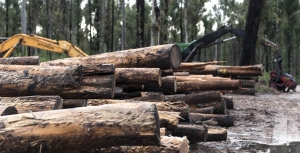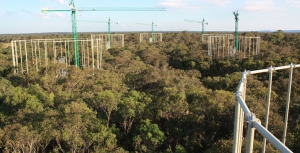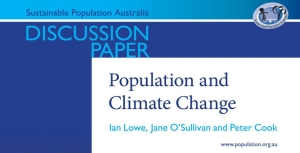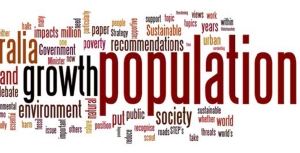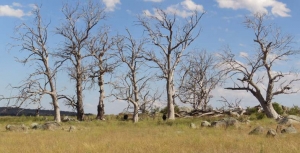Displaying items by tag: climate change
Ending native forest logging would help Australia’s climate goals much more than planting trees
What is being overlooked in current international climate policy under the Paris Agreement is the crucial role of biodiversity in maintaining healthy ecosystems and their integrity, which keeps carbon stored in forests, not the atmosphere. Healthy ecosystems are more stable and resilient, with a lower risk of trees dying and lower rates of carbon emissions.
The way we currently count carbon stores risk creating incentives to plant new trees rather than protect existing forests. Yet old-growth forests store vastly more carbon than young saplings, which will take decades or even centuries to reach the same size.
Can ending native forest logging help the climate?
We’ll need to go further and ban logging in all native forests in Australia to help meet our net-zero emissions target, while meeting timber demand from better-managed and increased plantations.
Stopping native forest logging avoids the emissions released when forests are cut and burned. It would also allow continued forest growth and regrowth of previously logged areas, which draws down carbon from the atmosphere and increases the amount held in the forest ecosystem.
The natural biodiversity of our native forests makes them more resilient to external disturbances such as climate change. These forests have larger and more stable carbon stocks than logged areas, newly planted forests and plantations.
If we compare forests protected for conservation with those harvested for commodity production in the Victorian Central Highlands, research shows conservation delivers the greatest climate benefits through continued forest growth and accumulating carbon stocks.
There are growing calls to create the Great Forests National Park to the north and east of Melbourne, which would protect a further 355,000 hectares and more than double protected forests in the Central Highlands.
Net zero: deep, rapid, sustained cuts needed
The world’s nations are aiming to reach net zero by mid-century. Meeting this target will require deep and rapid cuts in carbon dioxide emissions as well as pulling carbon out of the atmosphere into land sinks, especially forests.
The land sector is unique in that it can be both a source (logging, agriculture) and a sink (forest regrowth, for instance) for carbon. The natural way forests take up carbon can be increased through natural regrowth or plantations.
Unfortunately, the current approach, based on IPCC guidelines, to counting this type of natural carbon storage can lead to perverse outcomes.
The carbon sink from forest regrowth only counts towards the “removals” part of net zero when it results from changes we make, such as ending native forest logging. It doesn’t count if it’s regrowth after a natural event such as a bushfire. It’s important to count only human-induced changes in our climate targets.
Tree planting, on the other hand, can be counted towards net-zero targets, despite the fact that newly planted trees will take centuries to sequester as much carbon as found in an old-growth forest.
This type of accounting – known as flow-based accounting – can mean a premium is placed on planting and maintaining young forests with high carbon uptake rates, overlooking the substantial benefits of protecting larger trees in native forests.
That is, this approach favours carbon sequestration (the process of taking carbon out of the atmosphere and storing it in wood) over carbon storage (the total carbon stocks already contained in a forest).
A comprehensive approach to forest carbon accounting would recognise both flows of carbon (as sequestration) and carbon stocks (as storage) contribute to the benefits that native forests offer for reducing emissions.
Carbon accounting needs more clarity
This becomes a problem when forests and fossil fuels are included in a net accounting framework, such as the one used in Australia’s national greenhouse gas inventory.
In net accounts, emissions (from fossil fuel and land sectors) within a year are added to removals, which includes the sequestration of carbon into forests and other ecosystems.
Because this type of accounting only counts the flows of carbon – not existing stocks – it omits the climate benefits of protecting existing forests, whose stored carbon dwarfs the amount Australia emits from fossil fuels each year.
But if we separated out targets for the fossil fuel and land sectors, we could properly treat forest carbon stocks as an asset, giving us incentives to protect them.
Another problem with net accounting is it treats all carbon as equivalent, meaning a tonne of carbon sequestered in trees compensates for a tonne of carbon from burned fossil fuels. This has no scientific basis. Carbon dioxide emissions are effectively permanent, as the buried carbon we dig up and burn stays in the atmosphere for millennia, while carbon in trees is temporary in comparison.
As trees grow, their carbon storage compensates for earlier logging and clearing emissions, which is an important climate benefit. But we’re not comparing apples and apples – forest carbon doesn’t compensate for fossil fuel emissions.
Logging bans are important – but no substitute for ending oil and gas
While ending the clearing and logging of native vegetation is vital for both climate and biodiversity, it’s no substitute for preventing emissions from fossil fuels.
To make this clearer, we must urgently set separate targets for emissions cuts for fossil fuels and increased carbon removal in the land sector. This will ensure phasing out fossil fuel use is not delayed by planting trees, and that the carbon stocks of biodiverse and carbon-dense native forests are protected.
Kate Dooley, Research Fellow, School of Geography, Earth and Atmospheric Sciences, The University of Melbourne
This article is republished from The Conversation under a Creative Commons license. Read the original article.
A fierce battle is being fought in the soil beneath our feet – and the implications for global warming are huge
As humanity continues to burn fossil fuels, the delicate balance of life on Earth is changing. That’s true of trees, many of which are growing faster as a result of increased carbon dioxide (CO₂) concentrations in our atmosphere.
But not all trees are responding in this way. In particular, eucalypts – Australia’s iconic forest trees – haven’t benefited from the increase in CO₂ as they were expected to.
Why not? Our new research, published today in Nature, shows it comes down to a below-ground battle for phosphorus, a mineral nutrient in soils that is essential for tree growth. The results suggest in some parts of the world, increased CO₂ means tiny bugs in the soil 'hold onto' their phosphorus, making less available for trees.
This is alarming news, because according to current projections, global forest growth is meant to limit damage from global warming.
What our study involved
Our study used data from a Western Sydney University experiment known as Eucalyptus Free Air CO₂ Enrichment, or EucFACE. The experiment is located in a century-old Cumberland plain woodland in Sydney’s Hawkesbury district.
CO₂ is released into the woodland through a computer‐controlled system. Scientists then monitor the effects on trees, soils and the broader ecosystem. Over six years, CO₂ was raised to the levels expected around the year 2050 (according to the current business-as-usual emissions trajectory).
Our previous studies found the woodland trees did not show any extra growth at high CO₂ levels. We suspected the low availability of soil phosphorus was the cause, and set out to test this.
Phosphorus is crucial to the process of photosynthesis that makes trees grow. Phosphorus in soil is provided by bugs known as microbes. These micro-organisms break down dead and decaying matter, and in the process change phosphorus into a form that plants can take up with their roots.
Most Australian soils are naturally low in phosphorus, because they are derived from ancient, nutrient-depleted rocks. The same is true for most soils in tropical and subtropical regions. That makes the phosphorus service provided by microbes even more important.
We sampled phosphorus in all parts of the ecosystem, tracing its journey from the soil to the trees. We found under high-CO₂ conditions the microbes keep more of the phosphorus they produce, to aid their own metabolism. This left less available for trees to take up.
This occurred despite the trees trying to 'bargain' for phosphorus by releasing extra carbon into the soil to feed the microbes.
What’s more, trees are big 'recyclers' of phosphorus – they remove half of the phosphorus from any leaf before it falls. But this was still not enough to support extra tree growth.
EucFACE is designed to predict the effects of rapidly rising atmospheric carbon dioxide on Australia’s unique native forests.
Why this matters
Our study is the first to show how the phosphorus cycle is affected by high CO₂ – and in particular, the role of soil microbes.
The results are important to predicting soil phosphorus availability, and plant productivity, in woodlands and forests as CO₂ levels increase in the atmosphere.
Current climate projections assume increasing CO₂ will lead to more forest growth globally. Forests are a vital carbon 'sink' – that is, they draw down carbon from the atmosphere. So the increased forest growth was projected to go some way to limiting the effects of climate change.
If our results are taken into account, future warming would be higher than current projections. However, it’s important to verify our results in other locations, with other tree species. New experiments are being formed by overseas teams, including in the Amazon rainforest, to test the findings.
Importantly, our results don’t mean that forests are not a crucial sink for carbon. Forests hold a vast quantity of carbon. Avoiding deforestation and planting new forests are both valuable means of maintaining and adding to carbon stores.
Our research demonstrates the importance of considering soils when growing trees. We also hope our research stimulates further efforts to find phosphorus in ecosystems, especially in tropical rainforests where phosphorus is often greatly limited.
Kristine Crous, Senior Lecturer, Hawkesbury Institute for the Environment, Western Sydney University; Belinda Medlyn, Distinguished Professor, Ecosystem Function and Integration, Western Sydney University, and David S Ellsworth, Professor of Plant Eco-physiology, Western Sydney University
This article is republished from The Conversation under a Creative Commons license. Read the original article.
Talk by Ian Dunlop – what kind of world do we want?
At our AGM on 4 November, Ian provided a clear message about the future of the Earth and humankind. He summed up with a quotation from a statement made in 2021 by Sir David King, former UK Chief Scientist:
What we do over the next three to five years will determine the future of humanity.
The talk was about global warming. It was also about the urgent need to change the paradigm of growth and capitalism that underpins our economic systems.
Firstly, here is some background to his arguments.
Club of Rome – limits to growth
Fifty years ago, the Club of Rome created a computer model that projected trends in the variables that define human society: population, food production, industrial output, pollution and use of non-renewable resources.
At the time all these variables were increasing and were assumed to continue to grow exponentially while the ability of technology to increase the efficiency of use of finite natural resources grew only linearly.
The model predicted that the continuation of these trends would lead to a limit in the second half of this century. The most probable result will be a sudden and uncontrolled decline in population and ecosystems with flow on effects on industrial capacity and the supply of our basic needs.
Many studies have shown that the trends predicted are proving to be realistic. The limit of available non-renewable resources is being reached which will affect our capacity to continue our current lifestyle. Our civilisation only works if it grows, but that growth is now destroying the resources that maintain the civilisation.
The most obvious limit – our climate
The recent extreme weather experience in many locations around the world and the reports from the scientific experts highlight that we are getting close to a situation where temperature increases will exceed the ideal set in the Paris Agreement of 1.5°C and the fall-back position of 2°C is becoming harder to achieve.
We are already reaching tipping points, namely changes in the Earth’s systems that will be impossible to reverse, such as melting of the Arctic and Antarctic ice sheets and boreal permafrost. Once these changes are set in train the trend of temperature increases and sea level rise will be even harder to reverse.
The climate system has a strong level of inertia so any response to a reduction in greenhouse gas emissions will take several years to have any effect on temperature levels.
If emission levels are not reduced urgently to zero, not just net zero, we are on a path to temperature increases of 3°C or even 5°C that will make human life on our planet unliveable for most people. Zero emissions is required to reduce the concentration of CO2 in the atmosphere that is the driving force behind climate change.
How can we turn around these frightening prospects?
There is a lot of optimism expressed about the ability of technology to slow down emissions. But implementation of these technologies is too slow. Forget about the conflict that we are experiencing. These security threats and the need to build up military capacity are less urgent. What we need is radical change in the economic system. Is this possible?
Ian Dunlop is a member of the think tank called Earth4All that focuses on systemic change for global well-being. They are presenting two scenarios:
- Too little too late – what if we continue on our current destructive path?
- Giant leap – what if we achieve the fastest transformation in history?
Earth4All has gathered leading thinkers to advice on the economic ideas that show the most promise to unite societies and bring long-term prosperity to the majority. The current trend of an increasing gap between rich and poor has to change. Instability will be the outcome if the poor have to bear the brunt of impacts from climate change.
There are five core changes that are needed:
- poverty – more government planning and less market influence in economic development
- inequality – transfers from the few rich to the many poor
- empowerment – education, health, contraception, and opportunity to all women
- food – regenerative agriculture, higher efficiency, fairer distribution
- energy – shift from fossil fuels to renewables, higher efficiency, carbon capture and storage
Forces working against change
The free market will not solve the problems. However, what the world needs is not profitable from the investor perspective using conventional criteria.
Existing jobs are threatened – we need to move from jobs creating emissions and using natural resources to jobs restoring nature and re-using materials
Government measures will not be popular. These will entail such measures as higher taxes and more regulation.
Ian Dunlop suggests that the disparity in wealth means that the richest 10% could pay to make these changes happen.
Change remains possible and solutions exist if we choose to take them. Cooperation, not conflict, is the essential ingredient.
Communities must speak out loudly, bluntly and frequently about the urgency for change.
Ian Dunlop has been a writer and activist on climate change for about 50 years and he is chair of the Australian Security Leaders Climate Group.
Population and climate change
This important discussion paper on population and climate change by Ian Lowe, Jane O’Sullivan and Peter Cook was published in February 2022 by Sustainable Population Australia. Here is their summary.
The relationship between population and climate change is complex. At a basic level, for a given lifestyle (consumption pattern), emissions of the greenhouse gases that cause climate change are directly proportional to the size of the population. For example, if Australia’s recent population growth rate of about 1.5% per year were to continue, in less than 50 years we would double our demands for energy, food, water and all natural resources. All else being equal, we would double our carbon footprint also. On the other hand, in a hypothetical world where we achieve lifestyles entirely free from greenhouse gas generation, how many of us there were would make no difference to the climate. But even if this were achievable, which is questionable, we could decarbonise our lifestyles more rapidly if population growth was not constantly adding to the demand for energy and resources. Hence, the rate of population growth will make a considerable difference to the cumulative emissions generated during the transition. Furthermore, population growth greatly increases our vulnerability to the impacts of climate change.
The population issue has had a controversial history which has led to the development of a ‘taboo’ against talking about population as a policy-relevant factor. This paper calls for a new level of maturity in discussing the population issue. It should no longer be acceptable for unfounded accusations of racism to be used to silence respectful and thoughtful discussions about population growth. It should no longer be acceptable – at an epochal moment of existential risk for human civilisation – for climate policy prescriptions to conspicuously exclude population-related actions in the face of abundant evidence (as reported in this paper) that such measures are feasible, effective and consistent with human rights and democratic values. Ending global population growth more swiftly and at a lower peak is a necessary but not sufficient condition for overcoming the climate crisis.
Population and consumption work together
The Intergovernmental Panel on Climate Change (IPCC) says:
Globally, economic and population growth continue to be the most important drivers of increases in CO2 emissions from fossil fuel combustion.
But these are not independent contributors to emissions; they multiply each other. Most emissions are attributable to the richest billion people, but their economic growth since 1970 has not increased their average emissions per person. The growth in emissions has come from lifting multitudes of poor people to a modest middle-class lifestyle in places like China and India.
It is futile to ‘blame’ past emissions on either population or consumption patterns when they are the product of both. What should be of more interest to us is the extent to which the future challenges of climate change, including emissions reduction and adaptation, can be lessened by giving due attention to population growth. This paper argues that our climate change response can’t afford to ignore the potential to minimise further population growth.
Slow-response actions are no less urgent
Nobody expects addressing population growth alone to solve climate change. There is no intention to deflect attention from high- emissions consumption patterns, nor to blame the poor for the excesses of the rich. Demographic inertia means that even concerted efforts to slow population growth are unlikely to have significant impact on the timescale demanded by the climate crisis. Measures to decarbonise our energy system and reverse the loss of vegetation and biodiversity are needed urgently in this decade, if we are to avoid catastrophic impacts of climate change. Measures to reduce childbirth will take decades to make an appreciable difference to greenhouse gas emissions and human demands on nature.
Nevertheless, how well we do in the second half of this century will depend more on what we do about population growth this decade than on any actions that will remain available to us in 2050. If the successful efforts to promote voluntary family planning adoption in the 1970s and ’80s had not been abandoned in the 1990s, the global population might now be on track to peak below 9 billion. Because of decisions made in the 1990s, we’re heading for 11 billion or more. But if we renew family planning efforts now, a peak below 10 billion is possible and we could end this century with fewer than 8 billion people. If we wait until 2050, 11+ billion would be locked in.
A slow fruition does not make population action any less urgent. As the proverb says, ‘The best time to plant a tree is 20 years ago. The second-best time is now.’ So it is with addressing global population. The climate crisis is largely a product of the short- sightedness of political responses decades ago. Those who say that reducing birth rates is too slow to be relevant to the climate change response are suffering the same short-sightedness that created the problem they seek to fix.
In rich countries, fewer people means lower emissions and fewer vulnerabilities
Any increase of population in the more affluent countries will add to those countries’ use of resources and their greenhouse gas emissions. In a rich country, having fewer children does more to slow climate change than any of the other actions often advocated, such as eating less meat, avoiding air travel or using only renewable energy. If immigration is high enough to cause population growth, it also increases a country’s emissions, but some people argue that it makes no difference globally. This is untrue: the average migrant to Australia increases their carbon footprint fourfold by adopting Australian lifestyles. While Australians have recently reduced their per capita emissions a little, Australia’s total emissions from energy have risen 49% since 1990 due entirely to population growth of 8.3 million people.
Australia is not only one of the world’s largest per capita emitters of greenhouse gases, it is also among the countries likely to be most affected, in terms of negative impacts on agriculture, water supply, bushfire threat and extreme weather events. All these threats are intensified by the threat-multiplier of population growth.
The current Australian government policy of encouraging high levels of migration could see the 2060 population approaching 40 million and continuing to grow rapidly. That scale of increase would significantly magnify the task of producing enough clean energy to meet our material needs within a responsible carbon budget. Australian agriculture is unlikely to feed that number during increasingly frequent and severe droughts, and water security will depend on costly and energy-intensive desalination or recycling. These serious vulnerabilities are entirely avoidable if we choose population stabilisation.
In poor countries, smaller families are essential for adaptation
Population growth heightens vulnerability to climate change to a much greater extent in poor, high-fertility countries. For most of these countries, population growth itself is a greater threat to security and wellbeing than climate change is. Saying this does not in any way diminish the serious impacts of climate change. However, if a projected 11–25% reduction in crop yields this century due to climate change is considered a crisis, it is absurd to claim, as many people do, that population growth in high-fertility countries is not important when it will diminish the available water and agricultural land per person by a factor of three or more, while ensuring high levels of unemployment and poor infrastructure provision. While family size should be considered part of emissions reduction efforts in rich countries, it should be integral to adaptation efforts in poor countries. Nevertheless, the emissions caused by growing numbers of the poor are not insignificant. Deforestation is particularly vulnerable to population pressure.
Currently, family planning services are badly underfunded, denying many women access to safe and reliable contraception. As a result, the fall in birth rates has been much slower than was anticipated a generation ago, unemployment is rampant and hunger is once more on the rise.
Many of the beneficial impacts of lower birth rates are enjoyed much more rapidly than their effect on carbon emissions. These benefits include greater autonomy of women, health of infants, food security of families, protection of biodiversity, employment prospects for youth and economic development of nations. If climate adaptation is dominating the agenda for international aid, it makes sense that family planning should be included as an adaptation measure.
Climate change will affect world population
The other side of the coin is the impact climate change is projected to have on population, through greater loss of life. The frequency of extreme heat events, floods and crop-destroying droughts is projected to increase substantially. Some Pacific islands and low-lying coastal areas will become uninhabitable, causing either loss of life or relocation of whole populations. Mass migrations could possibly in turn lead to conflict between the displaced people and those whose traditional lands they enter. However, responses to climate change can have some beneficial health impacts. Urban air pollution and indoor smoke exposure are both major causes of premature deaths, and might be substantially reduced by electrification of energy systems. It is difficult to anticipate the net effect on population trends.
Only low-population scenarios can keep warming below 2°C
The most compelling reason to include population in the climate change response is that climate mitigation models are only able to achieve sufficient emissions reduction if their scenarios assume a rapid peak and decline in global population. These assumptions are not readily visible: they are hidden under the labelling of scenarios such as ‘SSP1’ or ‘SSP2’. Without making these assumptions explicit, and discussing the actions that could help achieve the required birth reductions in a way that elevates people’s rights and freedoms, these scenarios can’t become reality.
Addressing population growth alone can’t solve climate change, but not addressing it will ensure we fail.
Feeling adrift in a sea of false hope
A couple of months ago, I sat in on an Australian Conservation Foundation (ACF) event via Zoom for its donors and supporters that promoted its latest climate change campaign. As a long-serving councillor and former vice president of ACF, I was interested to hear about their campaign plans, which they explained are based on a poll of 15,000 people who indicated a desire for firm action on climate change. However, at the end of it, I felt isolated and alone. I felt I had moved on in my thinking, while ACF has not.
The presentations by senior ACF staff were earnest and uplifting and the comments posted in response were enthusiastic and supportive. But I felt myself estranged from the event. I found myself recalling how often, over my 30 years of enthusiastic involvement with ACF, I had felt uplifted and inspired by the same style of presentations by ACF’s key personnel. Now, not so and it felt a bit like having lost a faith.
So, what has changed for me as ACF barrels along in its customary manner? It comes down to a realisation that ACF, and environmentalism more generally, is stuck with talking about the symptoms of the environmental crisis, while ignoring the underlying causes. It is also locked into a largely fruitless campaign mode that is focused on targeting marginal seats in each Federal election. This has been its style since I joined its council in the 1980s and it remains a deeply entrenched, culturally embedded modus operandi.
The ACF people are intelligent, well-meant and deeply committed environmentalists, and for that they have my great respect. But they, and seemingly their supporters and donors who joined in this event, now appear to me to be tunnel-visioned and misguided in their fervour. First, and foremost, there is the assumption that climate change is the major existential threat that ACF and the wider environmental movement must address. It is their highest priority. And second, there is the additional assumption that this threat can be averted through a political campaign focussed on key marginal seats that will somehow bring about a radically different response. I hear myself thinking, ‘same old, same old’, looking back over forty years of ACF campaigning strategy. When will the penny drop that this is a fruitless strategy?
I could have submitted a comment to the event along the following lines:
When will ACF connect its climate change and biodiversity work to a deeper sustainability agenda that encompasses population growth, consumption, economic growth and technology – the underlying drivers of imminent collapse?
That would have been a real ‘party pooper’ contribution that I am sure would not have been welcomed by the ACF organisers on the night. It probably also would have been dismissed as inappropriate or irrelevant by most of the supporters and donors participating in the event.
The reality is that these deeper and more complex issues have been either ignored or dismissed by most ACF staff for much of its existence. This is despite the efforts of a number of its elected councillors and former Presidents over many years (ranging from Sir Garfield Barwick in the early 1970s to Emeritus Professor Ian Lowe more recently), to draw attention to them. The focus within ACF staff remains on an agenda dominated by the twin environmental pillars of climate change and biodiversity. But it would be unfair to level this criticism only at ACF. The environmental movement more generally, both here in Australia and in most other Western countries overseas, has largely displayed the same myopia in framing their campaigning and advocacy efforts.
As to the reasons for this behaviour, a fellow ex-ACF councillor, Jonathan Miller, offered me recently the following salient observations:
- The internal perception that it is easier to attract public support for issues such as climate change and biodiversity than for complex and less tangible issues such as population growth, consumption and economic growth.
- The additional perception that tackling the drivers of unsustainability is more difficult conceptually, much harder to win in the long-term and that it is more difficult to identify ‘wins’ to supporters and members.
- A shift in the profile of ACF (and other ENGO organisation) activists and their collective culture from those who deeply understand and love the bush (e.g. bushwalkers and those with natural science degrees) to those with broader social issue concerns (and whom, in turn, are particularly reluctant to tackle issues such as immigration-driven population growth in Australia).
Reinforcing the first of these points, the US founder of the Post Carbon Institute, Richard Heinberg, has offered the following observation about environmentalists more generally in a recent blog (The Only Long-Range Solution to Climate Change, Museletter #343 September 2021):
It’s understandable why most environmentalists frame global warming the way they do (by targeting the fossil fuel industry). It makes solutions seem easier to achieve. But if we’re just soothing ourselves while failing to actually stave off disaster, or even to understand our problems, what’s the point?
This succinctly echoes exactly where my own thoughts have arrived at after over 40 years of involvement with environmental law and environmentalism. I have come to believe that:
- climate change is essentially a symptom (admittedly a very powerful one) of an underlying ‘growth’ disease; and
- that the current political system, which is the hand maiden of capitalism and completely in its capture, is incapable of producing an effective response to climate change, much less the deeper challenge of avoiding ecological collapse and transitioning to sustainability.
On the latter score, the efforts by ACF and other ENGO’s to scramble for the crumbs falling from the table at each, successive federal election, seem both flawed and largely fruitless. Over the years, even though ACF does not directly support any political party, it has often engaged in targeting marginal seats where the ALP may have a chance of defeating the Coalition. The relationship with the Australian Greens has remained strained. And, after watching on ABC TV this week the first episode of the series, Big Deal, which laid bare the lack of any safeguards with respect to corporate political donations, it is clear where the most powerful influences on federal politics come from.
So, this is why I am left feeling alone and isolated. Where are the voices to raise the larger sustainability agenda? What is the point of environmentalism, however well-intentioned, if it proceeds in almost deliberate disregard of this larger agenda? How can this agenda be pursued when those most likely to support it do not, or are not willing to, recognise it? And what is the point of trying to engage with the current, corrupt political system in which a large proportion of Australian citizens have lost all confidence?
My response to these questions, perhaps surprisingly, remains hopeful. There are many voices emerging globally in support of a deeper sustainability agenda, including some luminaries in Australia. Environmentalism has been a meritorious movement over the past fifty years but it now must be seen as one that is limited in its vision and incapable of promoting a deeper sustainability agenda. This agenda must and will emerge from other sources and directions. And the goal must be to promote this agenda through radical social, economic and political reforms – these will be the pathways of the transition to a sustainable future that embodies ecological resilience and a human civilisation that is living within its means.
To develop these ideas further, I am engaged currently in writing a book entitled The Great Transition: From the Anthropocene to the Ecolocene which I hope to get published in about eighteen months from now.
This article is reproduced with permission. It was published in the Sustainable Population Australia newsletter, issue #145, November 2021. It was written by Rob Fowler, Adjunct Professor at the School of Law, University of Adelaide. He was a vice-president of the ACF from 2008 to 2015.
What does net zero greenhouse gas emissions actually mean?
Under the Paris climate change agreement the majority of countries have made pledges to get their greenhouse gas emissions down to ‘net zero’ by 2050 with the hope of keeping the global average temperature increase below 2°C and, preferably, no more than 1.5°C.
Australia is still an appalling laggard with no commitment by the Morrison government or any plan to achieve a goal of any sort. The commitment for 2030 of a reduction of 26 to 28% below 2005 levels is also being eclipsed by stronger commitments being made by many developed countries.
The world still has a long way to go to get to net zero. Many scientists are calling for a much faster reduction. The average global temperature has already increased by 1.1°C since pre-industrial levels and Australia’s increase is 1.44°C since 1910 when reliable data is available. It seems that reaching 1.5°C is inevitable so the Glasgow meeting is crucial to put in place actual policies, not just pledges, that will have provide a high probability that we won’t get beyond 2°C. Every fraction of a degree counts.
Definition of net zero
Net zero emissions describes the point in time when humans stop adding to the burden of climate-heating gases in the atmosphere. It refers to achieving an overall balance between greenhouse gas emissions produced and greenhouse gas emissions taken out of the atmosphere. The level of balance was approximately at the time before the world started burning coal during the 18th century. The level of CO2 then was about 280 ppm. It is now about 417 ppm. Actual worldwide CO2 emissions are currently about 35 billion tonnes pa. The net effect of the natural land and ocean absorption processes leaves the situation where the CO2 concentration in the atmosphere is still increasing, by 2.4 ppm pa over the past decade.
This data does not include emissions of the greenhouse gases methane and nitrous dioxides that have strong effects of atmospheric warming but are dissipated by chemical reaction relatively quickly. The following information focusses on CO2 emissions because they remain in the atmosphere for hundreds of years.
Getting to net zero means we can still produce some emissions, as long as they are offset by processes that reduce greenhouse gases already in the atmosphere. For example, these could be things like planting new forests, or drawdown technologies like direct air capture.
However, to meet the goal of net zero, new emissions of greenhouse gas must be as low as possible. This means that we need to rapidly phase out fossil fuels – coal, oil and gas – and transition to renewable energy.
Climate change isn’t a tap we can turn off once we stop using fossil fuels. Carbon dioxide, the main contributor to climate change, will stay in the atmosphere and keep heating the planet for years and years. As the data above shows there is already an excess quantity of greenhouse gases in the atmosphere that are having an impact on our climate so that we actually need to remove the excess in order to stop further increases in temperature and other effects of climate change.
Carbon offsetting options
Currently the main method of reducing emissions, called carbon offsetting, is planting trees. A massive area of land would be needed to make a big difference to total emissions. As a forest ages, it reaches what ecologists call a ‘steady state’ – this is when the amount of carbon absorbed by the trees each year is perfectly balanced by the CO₂ released through the breathing of the plants themselves and the trillions of decomposer microbes underground. So new areas will need to be planted out every year as emissions remain positive.
The calculation of the carbon content of a tree cannot be accurate unless the tree is pulled out of the ground so approximations are needed. Also the growth of each tree is non-linear, starting slowly and then the greatest sequestration rate is in the younger stages of tree growth, depending on rates and peaks of individual species, with the sequestration of CO2 per year dropping thereafter. The usual method is to choose the appropriate time scale and average the amount of carbon stored over that period.
Multiple factors such as growth conditions are at play so there is still much research needed into more accurate calculations. Of course the basic assumption is that the trees will remain standing. They won’t be burned down or degrade through drought of insect attack.
Once trees reach maturity they need to be locked away and then new areas need to be planted if more emissions need to be offset.
There are lots of other schemes for reducing emissions. The federal government is supporting ideas like carbon farming, avoided reforestation and land restoration.
A large market has developed for carbon credits that are calculated under schemes developed by under the UNFCCC. Some of these are available to governments and are popular with companies and individuals wanting to offset their emissions. The credits are sold by organisations that are running projects that reduce emissions, for example by supporting renewable energy in developing countries.
Have any countries or Australian states reached net zero emissions already?
Five countries have a net-zero target in place by law: Sweden, the United Kingdom, France, Denmark and New Zealand.
Closer to home, some of the states and territories are doing well. Australia’s states and territories all have net zero targets, but most governments have not outlined how these targets will be met. Tasmania has been net zero in some individual years. In 2014 and 2018, Tasmania’s emissions dropped below net zero thanks to Tasmania’s massive hydroelectric dams, and massive carbon-dense forests. With the state’s electricity supply already nearing 100% renewable, the remaining emissions from the state – across transport, manufacturing, agriculture and forestry – were offset by the greenhouse gases sucked out of the atmosphere by the state’s forests.
A target is only as good as the policies underpinning it. Several governments with a net zero goal, such as Western Australia, Northern Territory and Queensland, are still increasing their emissions each year. Even governments that are leading the pack when it comes to climate action – like South Australia and the ACT – still have more work to do to outline how they will meet their net zero goals.
The big concern is there are still new coal mining and gas projects being developed. It all seems very hypocritical for NSW to be supporting the Santos Pilliga gas project and mine expansion.
2040 – Join the Regeneration
STEP is supporting the screening of the film 2040 at Roseville Cinema. Booking is essential. We need a minimum of 68 bookings before the screening can go ahead. Your payment will be refunded if this number is not reached.
The previous screening organised by Ku-ring-gai Council in July was booked out.
2040 is a hybrid feature documentary that looks to the future, but is vitally important NOW! Award-winning director Damon Gameau (That Sugar Film) embarks on journey to explore what the future could look like by the year 2040 if we simply embraced the best solutions already available to us to improve our planet and shifted them rapidly into the mainstream.
Structured as a visual letter to his 4-year-old daughter, Damon blends traditional documentary with dramatised sequences and high-end visual effects to create a vision board of how these solutions could regenerate the world for future generations.
Which Urban Trees can Survive a Changing Climate?
There is lots of research demonstrating the benefits of trees in urban areas. Not only do they camouflage the grey asphalt and concrete of roads and footpaths, they can reduce temperatures and the need for air conditioning in buildings. They also improve the microclimate by retaining moisture in the air and soil and they encourage residents to get out into the community and enjoy beautiful shaded areas.
Tree planting is an effective and efficient way to adapt to climate change. However as climate change leads to higher temperatures and more variable and lower rainfall we need to consider how the popular trees used in urban areas will respond to the changes.
Different species have different levels of tolerance of heat, lack of water and other threats posed by climate change.
Research teams from Macquarie University (including former STEP president Prof Michelle Leishman) and Western Sydney University, have embarked on a project called Which Plant Where. The project is supported by Hort Innovation Australia, the Department of Planning, Industry and Environment and the Australian government. Their mission is to find the best plant species for urban landscapes that will be resilient to climate change.
The project works with the nursery industry to gather evidence on species’ resilience to extreme heat and drought by testing plants to their limits in research glasshouses. This work will inform plant growers and nurseries on how to adapt their business, by identifying the new challenges posed by climate change, as well as selecting diverse ranges of climate-ready species. They advise landscape architects, designers and urban planners about not only the best planting choices, but also how to increase the biodiversity of our cities.
We need to know how our current tree canopy will be affected as well as plan new plantings.
The research team recently published a study (Burley et al) that investigated likely climate change impacts on 176 of the most common tree species planted across Australian cities. The analysis showed more than 70% of these species will experience harsher climatic conditions across Australian cities by 2070.
Some of the most commonly planted trees are unlikely to survive. Conversely, in some cooler climate areas, such as Orange, the number of suitable species may increase. These impacts will progressively worsen as climate change intensifies. A proactive approach is needed to identify new climate-ready species and plantings. Tree species growing in warmer cities are more likely to be affected than those in cooler cities. Some species, such as the golden wattle (Acacia longifolia) or the prickly paperbark (Melaleuca styphelioides) might not make it in northern cities unless we invest precious resources – such as water – to maintain these civic assets. Other species, such as the native frangipani (Hymenosporum flavum) or the tuckeroo (Cupaniopsis anacardioides) will likely become more suitable for planting in southern cities.
Australian cities are blessed with a higher diversity of tree species compared to other cities globally. However, the 30 most commonly planted species make up more than half of Australia’s urban forests. This poses a great risk for our cities. If we were to lose one or two of these common species, the impact on our urban tree cover would be immense. Trees are a long-term investment that will be affected by the very factors that they are meant to mitigate. Consequently, our best insurance is to increase the diversity of our trees.
The study highlights the need for more research:
- which species experience a reduction in growth or, even mortality, during extreme weather events and the duration of any growth reduction
- variation of impacts in different climate zones, for example subtropical areas are likely to experience greater declines in growth than temperate areas
- whether it is feasible with some species to mitigate impacts by providing more irrigation, selective pruning or planting in a more sheltered position
- investigate new choices of species suitable for the urban environment from the huge range of Australian native species
The NSW government announced a plan in February to plant five million trees in Greater Sydney by 2030. They are counting trees planted in streets, parks, backyards, neighbourhoods and schools with an objective of increasing the tree canopy from 16.8% to 40%. Councils can apply for grants for tree planting projects. Individuals can register the trees they plant.
Reference
Hugh Burley, Linda J. Beaumont, Alessandro Ossola, John B. Baumgartner, Rachael Gallagher, Shawn Laffan, Manuel Esperon-Rodriguez, Anthony Manea, Michelle R. Leishman (2019) Substantial declines in urban tree habitat predicted under climate change, Science of the Total Environment 685, 451–462
Invitation to Participate in the Recent Climate-driven Ecological Change in Australia Project
Over the past century, average land surface temperatures have risen by almost 1°C across the Australian continent. Models suggest this may have already had significant impacts on Australia’s ecosystems and biodiversity, but these impacts have not been systematically investigated.
CSIRO Land and Water and the Department of the Environment and Energy are undertaking an exciting project to collect observations and anecdotes that will help to build a national picture of the kinds of ecological changes that have been occurring across the country over the past 10 to 20 years or more, and where changes may not have been occurring. We are looking for people with strong links to Australian environments (e.g. farmers, natural resource managers, ecologists, naturalists, rural scientists) to share their perceptions of recent ecological change (or lack of it) in an area they know well, and how this might link with climate or other change.
To participate, you would need to be able to select a natural area (e.g. your local region or farm, a nature reserve, urban bushland) that you have been familiar with for at least the last 10 years. Note that we are interested both in areas where change has been observed and where change has not been observed.
The survey will take about 30 min. Click here for additional information about the project.
Finkel Review on the Electricity Market – What Happens Now?
The Chief Scientist, Dr Alan Finkel, was asked by the Council of Australian Governments (COAG) to undertake an independent review of the national electricity market (NEM) that:
- delivers on Australia’s emissions reduction commitments
- provides affordable electricity
- ensures a high level of security and reliability
This was complicated task that needed to take into account:
- the closure of ageing coal-fired power stations
- escalating extreme weather events (like heatwaves, bushfires and storms) driven by climate change that test the resilience of the system
- increasing gas prices
- rapidly declining costs of wind, solar and battery storage
It also had to be politically palatable for the federal and state governments.
The energy users, the general public and industry just want long-term policy certainty.
The major points made by the review and the Climate Council’s view are summarised below.
1. Emission Reductions
The minimum target for reducing emissions in the electricity sector should be a 28% emissions reduction below 2005 levels by 2030. While it places responsibility for more aspirational targets to 2030 and beyond with government(s), the review cautions higher targets could have ‘larger consequences for energy security’ and ‘implications should be re-examined’.
This target is consistent with the commitment made by Australia at the Paris Climate Change conference but the electricity sector needs to bear a greater share of the reduction. It is easier to reduce emissions in the electricity sector as many of the required technologies already exist and reductions in other sectors like transport and land use are harder to achieve. The Climate Change Authority, the government appointed advisory body, suggested that electricity emissions should reduce by two-thirds by 2030 and be zero by 2050.
2. Clean Energy Target
The Finkel Review proposes introducing a Clean Energy Target, which would effectively replace the current Renewable Energy Target from 2020. Gas and coal (with carbon capture and storage) would qualify under the Clean Energy Target, as well as renewable energy. The Clean Energy Target would set a certain target amount of new ‘clean’ electricity (expressed as GWh or % of electricity) based on the required emissions reductions for the electricity sector. The Finkel Review leaves the target baseline and emissions trajectory to 2030 and beyond for politicians to decide.
Technologies with lower emissions, like renewables, would receive higher benefits than those with higher emissions, like gas and coal (which would still be required to be below a set emissions intensity level to receive any benefit). New coal stations that do not meet the target can still be built without penalty, increasing the emissions reduction burden from ‘clean’ electricity.
The Clean Energy Council website explains this mechanism in more detail. Modelling undertaken for the Finkel Review (based on 28% emissions reduction for the electricity sector) indicates the Clean Energy Target mechanism (and an emissions intensity scheme) would result in lower costs to households and businesses compared with no action at all (business as usual). The modelling shows renewable power continuing to grow, up to 42% of electricity supply by 2030 (58% still comes from fossil fuels by then, with no further brown coal closures), in contrast to business as usual of 35% renewable electricity.
Power generated by renewable energy in 2030 under the proposed Clean Energy Target – at 42% – is far too low. Under the Clean Energy Target, electricity supply from large scale renewable energy would only increase 9% from 2020–30 (about the same increase as has occurred in the past ten years, a decade marked by significant climate and energy policy uncertainty).
3. Renewable Energy Reliability
The Finkel Review recommends a new requirement on new wind and solar power plants to provide a certain level of ‘dispatchable’ capacity (this was called a Generator Reliability Obligation). Dispatchable capacity is electricity that is available on call, as and when needed. New wind and solar would be required to provide a certain amount of battery storage or gas generation as determined by energy market bodies so that power is available with certainty, for example, when the wind isn’t blowing and other sources cannot provide sufficient power.
There was no equivalent requirement placed on new, or existing ageing gas or coal generation, despite the failure rate of ageing power stations increasing. For instance, in early February 2017, a severe heatwave across much of Australia’s south east and interior caused supply issues for the South Australian and NSW energy systems at a time of peak demand. In NSW around 3000 MW of coal and gas power capacity was not available when needed in the heatwave. High power users in industry were required to scale back production at great cost.
4. Future of Coal
The Finkel Review recommendations focus on incentives to encourage new lower emissions power plants to be built, rather than phasing out or penalising polluting coal and gas plants. So the approach is intended to bring on new renewables without incentivising the phase out of existing polluting coal generators. Coal generation would continue to provide over 50% of Australia’s electricity by 2030 and 24% by 2050.
Coal should be phased out much more quickly. Australia’s coal-fired power stations are old, and polluting by world standards. The Finkel Review acknowledges that by 2035:
… approximately 68% of the current coal generating plants will have reached 50 years of age.
Its modelling shows most still operating at 2030 and some even by 2050. The review even considers it a ‘benefit’ for these old, polluting coal plants to continue operating.
The key recommendation for coal-fired power is a new requirement for power plants to provide three years notice before closing. A schedule for the closure of aged plants should have been established years ago.
5. Future of Gas
The Finkel Review provides for a continuing role for gas power generation despites the issues with methane emissions and local environmental impacts of coal seam gas extraction. It acknowledges gas prices (and, as a result gas power prices) will continue to rise in future due to the demands of liquefied natural gas exports from Queensland, and the increasing price of producing gas from unconventional gas fields.
At current gas market conditions, it observes that battery storage may be more cost effective than gas in providing security and reliability in the near future. However, the Finkel Review paradoxically urges government and industry to prioritise gas exploration and development.
See STEP Matters Issue 190 for more details on the issues with gas powered electricity.
Government Response
The Turnbull government has supported all the recommendations except the Clean Energy Target. They can’t get away from the vested interests of the coal industry. There are even rumours that they would consider providing financial support for a new ‘clean’ coal-fired power plant.
Coal-fired power is on the way out, globally, and in Australia. Clean coal is very expensive, if not technically impossible. But using public funds to prop-up this 19th century technology would lock in climate-destroying pollution and higher power prices for decades to come.
The Turnbull government is out of step with state/territory and local governments. State and territory governments are already on track to deliver the Clean Energy Target on their own:
- Victoria, Queensland, Northern Territory and South Australia are set to generate 40–50% renewable energy by 2030
- Tasmania is already running off 90% renewable energy
- ACT has contracted enough renewable energy to meet all its electricity needs by 2020
The states are setting strong targets that will help Australia reach net zero emissions by (and ideally before) 2050 in order to protect Australians from worsening climate impacts.
South Australia is about to get a 150 MW solar thermal power plant that will meet 5% of the state’s power needs. The 150 MW plant near Port Augusta is expected to be operational by 2020 and will power all the South Australian government's electricity needs. The plant uses the sun as a source of heat that is reflected by mirrors onto a tower containing molten salt that is used to create steam that drives a turbine. It is expected that more of these plants will be built.
Several local governments including Ku-ring-gai, Willoughby and North Sydney, have signed up with the City Powers Partnership set up by the Climate Council. Local councils who join the partnership pledge to take five key actions across renewable energy, efficiency, transport and working together. The partnership acts as a support network for sharing expert information and establishing joint projects.
The information in this article is sourced from the Climate Council’s commentary called Unpacking the Finkel Review.

